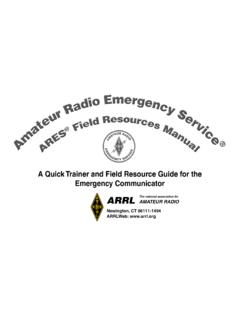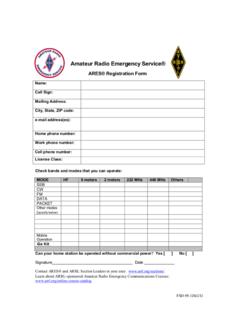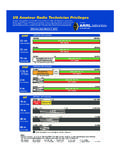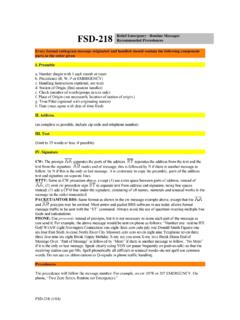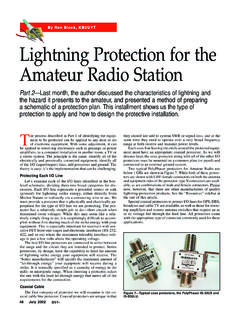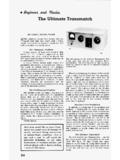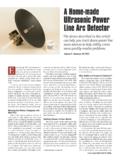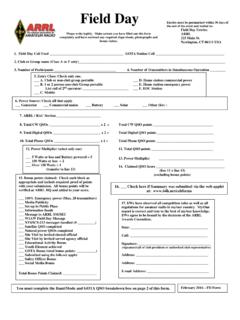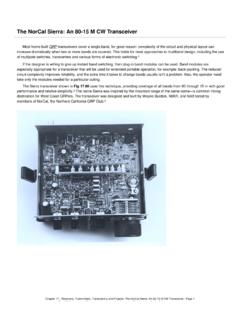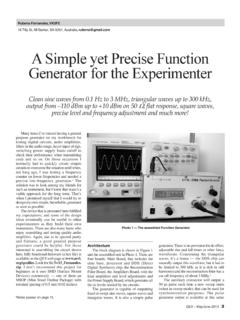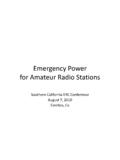Transcription of CFR Title 47: Telecommunication PART 97—AMATEUR …
1 CFR Title 47: Telecommunication PART 97 amateur radio SERVICE Contents Subpart A-General Provisions Basis and purpose. Definitions. Station license required. Control operator required. Operator license grant. Stations aboard ships or aircraft. Restrictions on station location. Station antenna structures. Application for new license grant. Application for a vanity call sign. Application for a modified or renewed license grant. Mailing address. License term. FCC modification of station license grant. Replacement license grant document. Cancellation on account of the licensee's death.
2 Subpart B-Station Operation Standards General standards. Station licensee responsibilities. Control operator duties. Reciprocal operating authority. Station control. Authorized transmissions. Prohibited transmissions. Third party communications. International communications. Station identification. Restricted operation. Subpart C-Special Operations Auxiliary station. Beacon station. Repeater station. Space station. Earth station. Space telecommand station. Telecommand of an amateur station. Telecommand of model craft. Telemetry. Message forwarding system.
3 Automatically controlled digital station. Subpart D-Technical Standards Authorized frequency bands. Frequency sharing requirements. Authorized emission types. Emission standards. RTTY and data emission codes. SS emission types. Transmitter power standards. Certification of external RF power amplifiers. Standards for certification of external RF power amplifiers. Subpart E-Providing Emergency Communications Operation during a disaster. Safety of life and protection of property. Station in distress. radio amateur civil emergency service. Subpart F-Qualifying Examination Systems Qualifying for an amateur operator license.
4 Element standards. Element credit. Preparing an examination. Administering VE requirements. Examinee conduct. VE session manager requirements. [Reserved] Coordinating examination sessions. VEC qualifications. Question pools. Accrediting VEs. Reimbursement for expenses. Appendix 1 to Part 97-Places Where the amateur Service is Regulated by the FCC Appendix 2 to Part 97-VEC Regions AUTHORITY: 48 Stat. 1066, 1082, as amended; 47 154, 303. Interpret or apply 48 Stat. 1064-1068, 1081-1105, as amended; 47 151-155, 301-609, unless otherwise noted. SOURCE: 54 FR 25857, June 20, 1989, unless otherwise noted.
5 EDITORIAL NOTE: Nomenclature changes to part 97 appear at 63 FR 54077, Oct. 8, 1998. Subpart A General Provisions Basis and purpose. The rules and regulations in this part are designed to provide an amateur radio service having a fundamental purpose as expressed in the following principles: (a) Recognition and enhancement of the value of the amateur service to the public as a voluntary noncommercial communication service, particularly with respect to providing emergency communications. (b) Continuation and extension of the amateur 's proven ability to contribute to the advancement of the radio art. (c) Encouragement and improvement of the amateur service through rules which provide for advancing skills in both the communication and technical phases of the art.
6 (d) Expansion of the existing reservoir within the amateur radio service of trained operators, technicians, and electronics experts. (e) Continuation and extension of the amateur 's unique ability to enhance international goodwill. Definitions. (a) The definitions of terms used in part 97 are: (1) amateur operator. A person named in an amateur operator/primary license station grant on the ULS consolidated licensee database to be the control operator of an amateur station. (2) amateur radio services . The amateur service, the amateur -satellite service and the radio amateur civil emergency service. (4) amateur service. A radiocommunication service for the purpose of self-training, intercommunication and technical investigations carried out by amateurs, that is, duly authorized persons interested in radio technique solely with a personal aim and without pecuniary interest.
7 (5) amateur station. A station in an amateur radio service consisting of the apparatus necessary for carrying on radiocommunications. (6) Automatic control. The use of devices and procedures for control of a station when it is transmitting so that compliance with the FCC Rules is achieved without the control operator being present at a control point. (7) Auxiliary station. An amateur station, other than in a message forwarding system, that is transmitting communications point-to-point within a system of cooperating amateur stations. (8) Bandwidth. The width of a frequency band outside of which the mean power of the transmitted signal is attenuated at least 26 dB below the mean power of the transmitted signal within the band.
8 (9) Beacon. An amateur station transmitting communications for the purposes of observation of propagation and reception or other related experimental activities. (10) Broadcasting. Transmissions intended for reception by the general public, either direct or relayed. (11) Call sign system. The method used to select a call sign for amateur station over-the-air identification purposes. The call sign systems are: (i) Sequential call sign system. The call sign is selected by the FCC from an alphabetized list corresponding to the geographic region of the licensee's mailing address and operator class. The call sign is shown on the license. The FCC will issue public announcements detailing the procedures of the sequential call sign system.
9 (ii) Vanity call sign system. The call sign is selected by the FCC from a list of call signs requested by the licensee. The call sign is shown on the license. The FCC will issue public announcements detailing the procedures of the vanity call sign system. (iii) Special event call sign system. The call sign is selected by the station licensee from a list of call signs shown on a common data base coordinated, maintained and disseminated by the amateur station special event call sign data base coordinators. The call sign must have the single letter prefix K, N or W, followed by a single numeral 0 through 9, followed by a single letter A through W or Y or Z (for example K1A).
10 The special event call sign is substituted for the call sign shown on the station license grant while the station is transmitting. The FCC will issue public announcements detailing the procedures of the special event call sign system. (12) CEPT radio amateur license. A license issued by a country belonging to the European Conference of Postal and Telecommunications Administrations (CEPT) that has adopted Recommendation T/R 61-01 (Nice 1985, Paris 1992, Nicosia 2003). (13) Control operator. An amateur operator designated by the licensee of a station to be responsible for the transmissions from that station to assure compliance with the FCC Rules.
